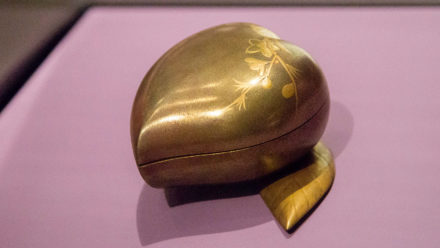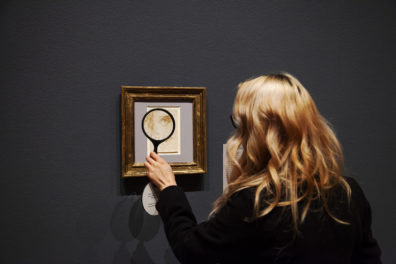Artist Alan Nakagawa’s “Myth Not Myth” project deconstructs misperceptions about ancient art through conversation and sculpture. To inspire his sculptures, which are presented free to the public in the Villa’s Outer Peristyle on June 11, 18, and 25, 2016, he interviewed Getty Museum staff, including conservator Marie Svoboda. She discussed how our modern expectations of art influence how we perceive ancient art, and how current conservation ethics seek to make evident what is original about an artifact—and what is not.
Listen to all of the Myth Not Myth interviews on Soundcloud »

Getty Museum conservator Marie Svoboda discusses perceptions of ancient art with visiting artist Alan Nakagawa in the Museum’s conservation studio
More to Explore
“Myth Not Myth” project description
“Myth Not Myth” event information
Transcript


[instrumental music interspersed throughout]
MARIE SVOBODA: Reminds me of a very funny story, that I brought my mom once to the museum when I first started working here. And, it’s all about understanding and perception, right? She walks in and she’s looking around and she’s really sad. I said, “You have to see this beautiful marble basin.” And it was a marble basin in our collection that had maybe 50 percent of its paint still remaining on it.
ALAN NAKAGAWA: Oh!
MARIE SVOBODA: I mean, it was almost 2,500 years old, which is amazing, right?
ALAN NAKAGAWA: Yeah, yeah.
MARIE SVOBODA: I show that to my mom and she goes, “I’m so sad.” She goes, “Where did all the paint go? It’s missing so much paint.” Andy I said, “No, you don’t understand. You’re looking at it in the completely reverse way because this is really old and it’s amazing that so much is preserved.”
ALAN NAKAGAWA: Right.
MARIE SVOBODA: She was thinking that she’d seen the broken sculptures or the missing arms or the missing paint that it was kind of a bad thing that we’ve lost so much, where … rather than thinking of how much we’ve gained by still having these things preserved. I thought, well, it’s all how you look at it.
ALAN NAKAGAWA: Half empty, half full?
MARIE SVOBODA: Right, exactly. Exactly.
What is the story you want to tell? How much information do you want to reveal or not reveal? Um, every piece is completely unique, so although I work mostly on ceramics, say, mostly in ceramics, no single, no two treatments are the same. They’re all different. Every artifact has a different history because it’s from a different soil and a different ground. Maybe one ground is very salty, one is not. One was alkaline. Maybe one had more moisture and more of this or that. The original materials and what they were made with. Did they have large inclusions in them and did those inclusions when the humidity changed, pop off the surface? You know, every piece behaves differently, has a different history in how it was, it’s lived, where it’s been buried or found, how it’s been stored in the collection.
And then your approach to dealing with it is different every single time. So, you may feel like you’re the master of your trade and then every single time you’re humbled because you realize, I have to start the process all over again, I have to get to know this object, understand it better.
Again, another reason for why we do the reversible stable materials in the choices of the restorations we do is so that, that helps continue that preservation. ‘Cause, what’s very clear to me, as long as I’ve been in the field, most of my work, and—I’m working in a museum, not in an archaeological dig—but, most of my work is treating other people’s restorations. I mean, I’m not treating antiquities. Yeah, the original artifact is an ancient artifact, but what I’m dealing with is the treatments that happened 200, 100, 50, 20, 5, 10 years ago from previous conservation treatments. And I’m going in and I’m improving on them or changing the materials so that we kind of follow this code of ethics of how we want things to last forever. But, um, …
ALAN NAKAGAWA: You’re stabilizing?
MARIE SVOBODA: Yeah. I’m stabilizing. Yeah, yeah.
With the Apulian vases that I worked on, I mean even when you were six feet away you could tell that half of it was not original, because instead of adding decoration or design, I did a flat neutral color. So, my goal was that it wouldn’t be distracting. You know, I wasn’t about to add design. I wasn’t about to falsify information. I wasn’t about to, especially add design that I didn’t know existed, but even repeating patterns or things like that, it was avoided. They were left neutral black. We completed the shape and that kind of allows the spectator to appreciate it as a complete vessel, but really be able to distinguish between the two, original and modern additions.
Here, we have to, our goal is to make things look complete and beautiful. But, to not take it that far: to apply what we call the “six inch, six foot” rule. So, when you’re six inches up close you can see all the repairs and restorations. You know what is original and what is not. When you’re six feet away it should all integrate together, so that you can appreciate the object as a whole, you can understand the shape of it, maybe some of the iconography, the coloration of it. It’s supposed to be pleasing and beautiful, but we don’t want to lose, we don’t want to falsify it so much that somebody who’s looking at it doesn’t understand that half of it is not original.
It was an exhibition that originated at the Sackler Museum in Boston, in Cambridge, Massachusetts, where it was one man’s study of ancient marbles and how they were painted in antiquity. And he studied—because so many don’t have paint on them or just tiny remains—but not only did he study the tiny remains that were there, but he studied the objects in a different light, because if they were painted for 50 years the stone eroded differently. So you could just barely make out some of the details of the decoration and he had reproductions made of all of these beautiful objects. Most of them were from the Parthenon. So, he showed what they would’ve looked like in antiquity. And people were shocked, because they’re used to seeing them without color and used to seeing them very bland and they couldn’t imagine that the colors were so vivid and intense and bright.
And he made a case that that’s indeed the way they were, that they were decorated and painted in that way, and most of it was because they were really high up and difficult to see, so, you know, bright colors, and that that was once very desirable, but it’s our whole approach and ascetic to now looking at these very plain bland white marble sculptures, not really understanding how they would have looked if they were once completely decorated. And, I think, maybe that’s … I mean, we would never repaint them the way they once looked, but we have the ability now to, kind of through didactics or through different types of media, to show people what they would’ve looked like as instructional material.
[instrumental music interspersed throughout]
MARIE SVOBODA: Reminds me of a very funny story, that I brought my mom once to the museum when I first started working here. And, it’s all about understanding and perception, right? She walks in and she’s looking around and she’...




Comments on this post are now closed.